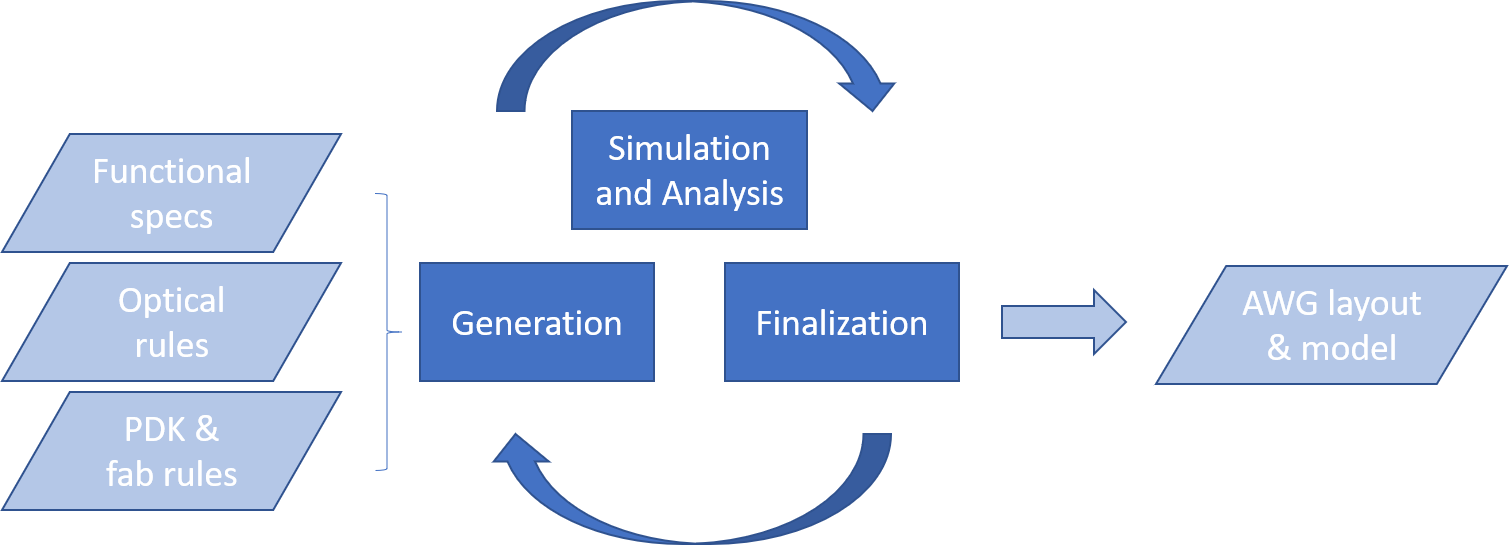Working with Luceda AWG Designer
Luceda AWG Designer offers an integrated design environment starting from a desired set of specifications to arrive at a manufacturable layout for an arrayed waveguide grating (AWG). It offers assistance and automation across all design steps:
Specification definition
Circuit synthesis
Simulation
Visualization
DRC-clean layout generation
Arrayed waveguide grating
An arrayed waveguide grating, or AWG, is a planar optical filter device which can process a range of optical channels at once. The most common applications for AWGs are as a multiplexer or demultiplexer device, or as an element in switches (e.g. crossbar). Since they can also influence the phase of the signals, they are sometimes used in dispersion compensation applications as well. Besides their use in telecom and datacom networks, they can also be employed in spectrometer devices, such as in medical sensing (e.g optical coherence tomography) or in mechanical sensing (e.g. fiber Bragg grating read-out).
AWGs have many parameters and offer a relatively large degree of freedom, though many parameters are coupled, leading to multiple design trade-offs. By using Luceda AWG Designer module, some of this complexity is removed by means of design automation, while keeping the flexibility to tailor the AWG design where needed.
An AWG consists of input/output waveguides, star couplers and a waveguide array connecting them.

The working principle of an AWG is simple. Light entering the first star coupler through the input waveguide is diffracted and coupled into the waveguide array with a specific phase difference between two successive arms. If we place the output waveguides at the right positions, wavelength channels can be demultiplexed into the various output waveguides.
Specification-driven workflow
The overall concept of using the Luceda AWG Designer is as follows:

The input consists of functional specifications, optical rules, and PDK and fab rules. Then, we iterate over the following stages:
AWG generation
First, the subcomponents (slab template, apertures and waveguide model) need to be designed.
Then, based on functional specifications and fab and optical rules, the AWGs are generated and implementation parameters, such as angles, positions, radii, delay length, are derived.
Finally, the AWG is implemented based on these implementation parameters: first the star couplers and then the full AWG.
AWG simulation and analysis.
In this step, the entire AWG is simulated from first principles. The results of the simulation are analyzed and high-level specs such as cross-talk or insertion loss are calculated.
AWG finalization.
Finally, the AWG design is finalized so that it can be easily integrated with the rest of the circuit, e.g. routing of its inputs and outputs to Manhattan directions, and saving the AWG layout and model for subsequent use within the Luceda Photonics Design Platform.
The output of the design flow is a finished AWG with a reusable layout and a circuit model.
Tutorials
We will explore this workflow in more detail and apply it to different applications throughout this series of tutorials.